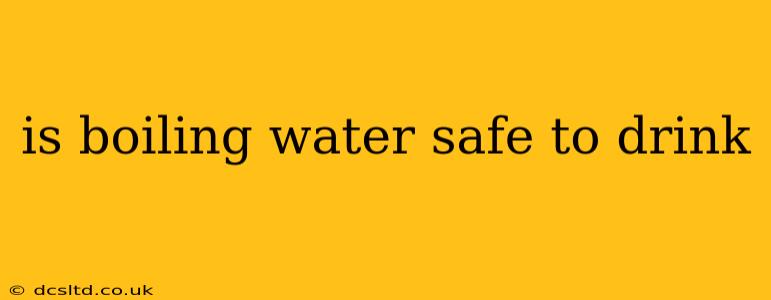Boiling water is a simple yet highly effective method for purifying water and making it safe for consumption. However, the safety of drinking boiled water depends on several factors, and it's not a universally foolproof solution for all water contamination issues. This guide will explore the safety of boiling water, addressing common concerns and providing a comprehensive overview.
Does boiling water kill bacteria and viruses?
Yes, boiling water effectively kills most harmful bacteria and viruses. The key is to reach and maintain a rolling boil for a sufficient duration. Most pathogenic microorganisms, responsible for waterborne illnesses like cholera, typhoid, and E. coli infections, are eliminated at temperatures above 212°F (100°C). The boiling process denatures the proteins within these microorganisms, rendering them harmless. The length of boiling time depends on your altitude; at higher altitudes, water boils at a lower temperature, requiring longer boiling times to ensure complete inactivation.
What about other contaminants? Does boiling remove chemicals?
Boiling water is highly effective against biological contaminants, but it's less effective against chemical contaminants. Boiling doesn't remove chemicals like pesticides, herbicides, heavy metals (lead, arsenic), or industrial pollutants. These contaminants remain in the water even after boiling. If you suspect your water source is contaminated with chemicals, boiling is not a sufficient purification method. You'll need other water treatment options like filtration or reverse osmosis.
How long should I boil water for it to be safe to drink?
The recommended boiling time is one minute at sea level. However, at higher altitudes, where water boils at a lower temperature, you'll need to boil the water for a longer period to ensure all harmful microorganisms are killed. A general rule of thumb is to boil vigorously for one minute after the water reaches a rolling boil. Once boiled, let the water cool completely before drinking.
Is it safe to boil water repeatedly?
While boiling water multiple times won't make it inherently unsafe, repeated boiling can increase the concentration of minerals and other dissolved solids. This is because the water volume decreases with each boil, concentrating the remaining minerals. While this isn't typically harmful, it can alter the taste and potentially lead to increased mineral intake over time. For optimal taste and to avoid mineral buildup, it's best to boil fresh water each time.
What are the benefits of boiling water?
Boiling water offers several key benefits:
- Kills harmful bacteria and viruses: This is the primary benefit, making it safe for consumption in areas with questionable water quality.
- Simple and inexpensive: Requires minimal equipment and resources, making it accessible to a wide range of populations.
- Effective in emergencies: A readily available method for purifying water during natural disasters or power outages.
- Improves taste: Boiling can sometimes improve the taste of water by removing unpleasant odors and volatile organic compounds.
When should I NOT rely on boiling water for purification?
Boiling water is not a suitable method for purifying water in all situations. You should not rely on boiling if:
- Your water is contaminated with chemicals: Boiling won't remove chemical contaminants.
- You lack access to a reliable heat source: Boiling requires a heat source capable of bringing water to a rolling boil.
- You have concerns about mineral buildup: Repeated boiling can lead to increased mineral concentration.
In conclusion, boiling water is a valuable and effective method for eliminating harmful bacteria and viruses from water, rendering it safe to drink. However, it's essential to understand its limitations and not rely on it as a solution for all water contamination issues. Always assess your water source and choose appropriate purification methods based on the specific contaminants present.
